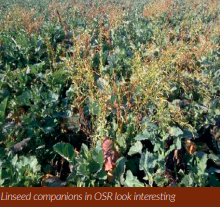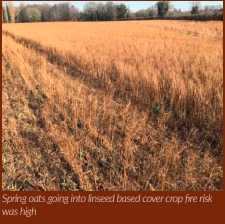Writing on 28th Feb 2019, David White brings readers up to date on early spring work on this Cambridgeshire farm.

Farming 160ha of combinable crops on light “boys” land over chalk between Cambridge and Newmarket. I’m 100% combinable having been a sugar beet grower since the days of hand hoeing as well as offering a drilling and harvesting service with a 6 row tanker in the past, I have since stopped growing beet when I wanted to start direct drilling. All crops types are grown for premium markets and are stored in Camgrain central storage which makes having a rotation of 6 or 7 crops and different varieties very easy.
Spring drilling Spring Beans and Elyann Oats were in the ground by Feb 27th with only a little barley to go into a thick cover crop of Black Oats and Vetch on some land with blackgrass issues, so no hurry for that. There has been some deliberation as to whether its been too early to sow but conditions have been too perfect to ignore. What a difference from last year which wasn’t great for spring crops.
The oats were drilled into 18” high desiccated Linseed/Phacelia mix and I had some concerns about the linseed being picked up on my milled toothed 750a covering wheels and wrapping on the axles. This fear proved to be unfounded as certainly drilling into the cover when it was dry was 100% trouble free. Small oat seed of 36TGW required 136kg/ha to establish 350 plants. Half the N around 65kgs will go on following the drill to kick it off and N cores will help decide on the balance required. Three metre wide assist strips for pollen and nectar species have been left through a large field which will be sown later in March.

Rape companions Spring beans (inc some Berseem) have proved most successful again in reducing CSFB larvae numbers. Although the plants are carrying more burden than last year most fields are at early stem extension with visible flower buds and will require some PGR treatment I’m advised, some will be done. This is in stark contrast to many conventionally established fields in the area that are shrinking and slowing turning brown! Interestingly a later Sept 2nd sown high seed rate no companion area is suffering much more from larvae even though it emerged after the peak CSFB flight period.
Nitrogen All the OSR and winter wheat have now had some nitrogen although they didn’t look like there was any urgency. We’ve had a dry winter so little N will have been leached but the rape has got to a good growth stage with only 29 kgs/N applied and the wheat looked very well pre first application which suggests to me that the companions and enhanced soil biology achieved through not tilling is doing something for me. 900 mm deep N cores kindly taken by Niab show 22-29 kgs/N available over that profile.
These soil cores also showed the subsoil to be very dry! Cane molasses was added to the liquid N+S application at 5lts/ha without any problems. I cautiously pre mixed 50-50 with water in IBCs as I wasn’t sure how the molasses handled. This makes measuring into the sprayer easy through a suction probe using the scale on the container. A series of nitrogen variation tramline trials is being set up to compare to a soil biology only control.

Growing my own companion seed Winter peas are now about 75mm high and at sowing rate of 100 seeds/ sq mt look fine. After some head scratching for a way to keep my vetch off the ground enough to enable a chance of successful combining I’ve sown it into a companion of spring beans at 80 kgs/ha, watch his space. I have started taking tissue samples to check on plant nutrition status again with the first results in showing most main elements being find. As a BASE UK committee member I’m involved with the planning of events for the late spring/early summer including an interesting European trip which members can look forward to.

